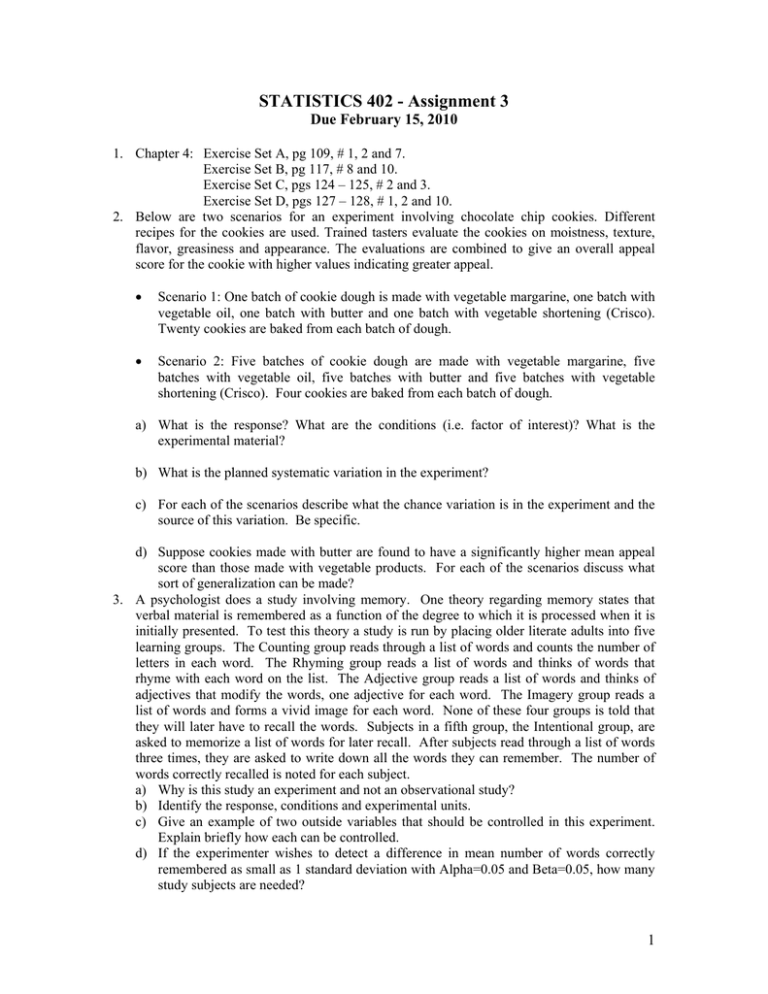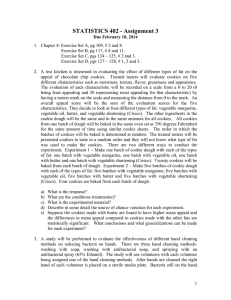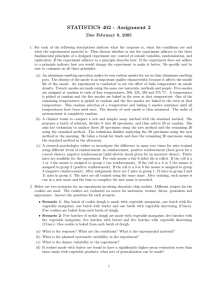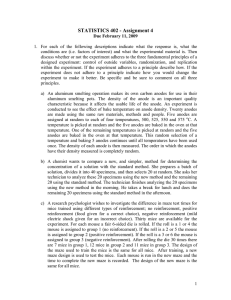STATISTICS 402 - Assignment 3 Due February 15, 2010
advertisement

STATISTICS 402 - Assignment 3 Due February 15, 2010 1. Chapter 4: Exercise Set A, pg 109, # 1, 2 and 7. Exercise Set B, pg 117, # 8 and 10. Exercise Set C, pgs 124 – 125, # 2 and 3. Exercise Set D, pgs 127 – 128, # 1, 2 and 10. 2. Below are two scenarios for an experiment involving chocolate chip cookies. Different recipes for the cookies are used. Trained tasters evaluate the cookies on moistness, texture, flavor, greasiness and appearance. The evaluations are combined to give an overall appeal score for the cookie with higher values indicating greater appeal. • Scenario 1: One batch of cookie dough is made with vegetable margarine, one batch with vegetable oil, one batch with butter and one batch with vegetable shortening (Crisco). Twenty cookies are baked from each batch of dough. • Scenario 2: Five batches of cookie dough are made with vegetable margarine, five batches with vegetable oil, five batches with butter and five batches with vegetable shortening (Crisco). Four cookies are baked from each batch of dough. a) What is the response? What are the conditions (i.e. factor of interest)? What is the experimental material? b) What is the planned systematic variation in the experiment? c) For each of the scenarios describe what the chance variation is in the experiment and the source of this variation. Be specific. d) Suppose cookies made with butter are found to have a significantly higher mean appeal score than those made with vegetable products. For each of the scenarios discuss what sort of generalization can be made? 3. A psychologist does a study involving memory. One theory regarding memory states that verbal material is remembered as a function of the degree to which it is processed when it is initially presented. To test this theory a study is run by placing older literate adults into five learning groups. The Counting group reads through a list of words and counts the number of letters in each word. The Rhyming group reads a list of words and thinks of words that rhyme with each word on the list. The Adjective group reads a list of words and thinks of adjectives that modify the words, one adjective for each word. The Imagery group reads a list of words and forms a vivid image for each word. None of these four groups is told that they will later have to recall the words. Subjects in a fifth group, the Intentional group, are asked to memorize a list of words for later recall. After subjects read through a list of words three times, they are asked to write down all the words they can remember. The number of words correctly recalled is noted for each subject. a) Why is this study an experiment and not an observational study? b) Identify the response, conditions and experimental units. c) Give an example of two outside variables that should be controlled in this experiment. Explain briefly how each can be controlled. d) If the experimenter wishes to detect a difference in mean number of words correctly remembered as small as 1 standard deviation with Alpha=0.05 and Beta=0.05, how many study subjects are needed? 1 e) The experimenter is able to recruit 50 study subjects. Give two combinations of Alpha, Beta and Δ σ that correspond to this number of volunteers. Briefly explain the trade-off between your two choices. f) Describe in detail how you would randomly assign the study subjects to the five groups so that there are an equal number of volunteers in each group. Once you have described what you will do, actually do the randomization. Include your randomized assignment of the 50 study subjects to the 5 groups. 4. A completely randomized experiment, as described in problem 3, is run with the following results. Counting Rhyming Adjective Imagery Intentional 9 7 11 12 10 8 9 13 11 19 6 6 8 16 14 8 6 6 11 5 10 6 14 9 10 4 11 11 23 11 6 6 13 12 14 5 3 13 10 15 7 8 10 19 11 7 7 11 11 11 7.0 6.9 11.0 13.4 12.0 Mean, y 1.826 2.132 2.494 4.502 3.742 Std. Dev., s a) Plot the data. If you use a computer program to plot the data, “cut” and “paste” the output on your answer sheet. Based on the plot what can you say about the effectiveness of the various learning methods? What can you say about the consistency of the learning methods? b) Estimate the effect of each of the learning methods. c) Construct an analysis of variance table giving sources of variation, degrees of freedom, sums of squares, mean squares, appropriate F statistic and associated P-value. If you use a computer package, you can copy the results from the output onto your answer sheet. d) Give the value of R2 and an interpretation of this value. e) Are there statistically significant differences amongst the five groups in terms of mean counts of remembered words? Support your answer by referring to the appropriate test of the null hypothesis: H 0 : μ1 = μ 2 = μ 3 = μ4 = μ5 . f) If there are statistically significant differences, which groups are different? Support your answer with a multiple comparisons method. Be sure to discuss the chance of committing at least one error in the set of pair-wise comparisons of groups. g) Look at the residuals plotted against the predicted values and the distribution of residuals. What do these plots tell you about the conditions necessary for the analysis of variance? Be sure to tell me what you see in the plots and how that relates to specific conditions. h) Write a brief summary (one or two sentences is enough) of the findings of the experiment. In this summary make a recommendation based on your analysis as to what learning method should be used. Note: If you use a computer program to analyze the data, include only the appropriate output to answer each question. It is helpful if the output used to answer a question is placed near the question and its answer. 2









